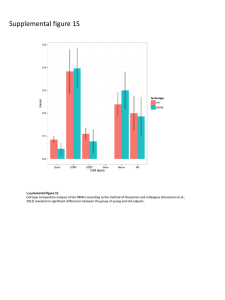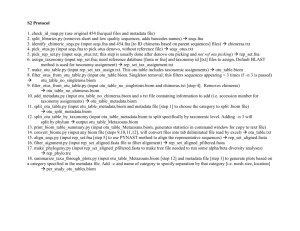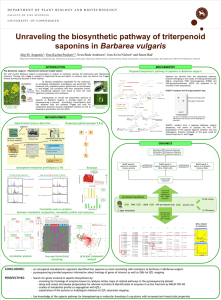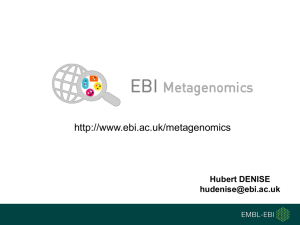Metabarcoding - Bioinformatics Institute
advertisement
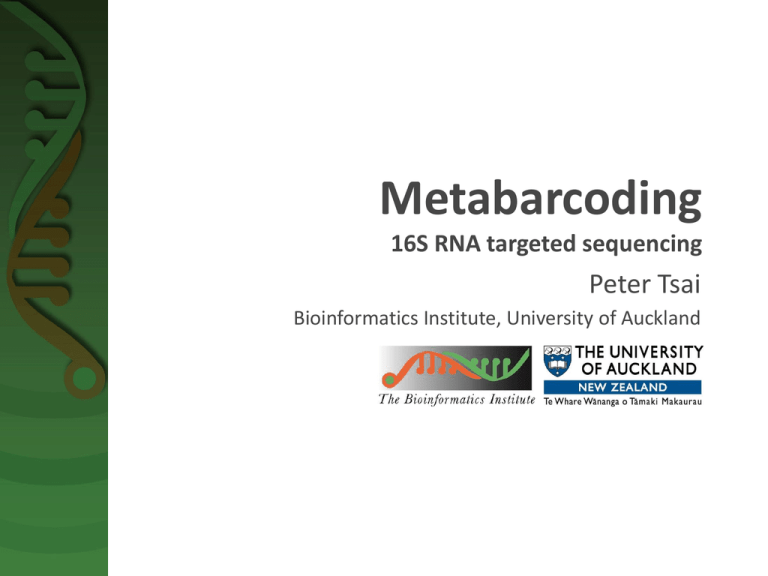
Metabarcoding 16S RNA targeted sequencing Peter Tsai Bioinformatics Institute, University of Auckland Overview What’s metagenomics and metabarcoding? Next generation sequencing and metabarcoding How NGS changes metagenomics Analysis approach Taxonomic dependent and independent analysis Study example NZ vine yeast biogeography by pyrosequencing Metagenomics Metagenomics Study of metagenomes, genetic materials directly from environmental samples. Shotgun metagenomics ◦ Randomly shears DNA, sequence many different species in environment and attempts to reconstruct multiple genomes. Metabarcoding Subset of metagenomics. Study of one or more marker gene. Gene specific primers to ‘barcode’ that gene, i.e. 16S, ITS or CO1 Aim is often to identify different species and compare different community NGS and metagenomics Accelerated by NGS, predominately 454 sequencing because of the longer read length, now more with Illumina based chemistry. Organism no longer needs to be cultivated and cloned — Culture independent insight Direct sequencing from environment as a “community” You can pool multiple samples together Not all microbes can be cultured Analysis approach Analysis approach Taxonomy independent analysis Reads are group into operational taxonomic units (OTU) based on a specified sequence variation. Taxonomy dependent analysis Assignment at the level of domain, phylum, class, order, family, genus, and species Require a reference database Taxonomy independent analysis Group reads into OTU based on certain imposed similarity threshold In study of bacteria, 97% seems like a good starting point Species dependent, genes dependent, threshold may vary 1 OTU = 1 organism Extract a OTU representative sequence Most common sequence Sequence that has minimum difference to all other sequences in the same OTU Taxonomy dependent analysis Classify sequences BLAST Simply BLAST what you have Online RDP classifier (Ribosomal Database Project ) RDP 10.26 (Release 10, Update 26 consists of 1,613,063 aligned and annotated 16S rRNA sequences Limited by number of reads you can submit Online Greengenes classifier based on NAST alignment Require pre-aligned dataset Limited by number of reads you can submit NZ vine yeast biogeography by pyrosequencing M. W. Taylor, N. Anfang, A. H. Thrimawithana, P. Tsai, H. Ross and M. R. Goddard School of Biological Sciences, University of Auckland NZ vine yeast biogeography by pyrosequencing Yeasts are the agents responsible for fermentation of fruits into wine Yeasts naturally associated with vines and wines are reasonably well characterised Microbes have an effect on both vine and fruit development (as some are pathogens), as well as the resulting wine quality and style Investigations into the ecology of these organisms is lacking. Vitis vinifera NZ vine yeast biogeography by pyrosequencing 6 distinct vineyards in each of four major and distinct wine-producing regions West Auckland (WA) Hawke’s Bay (HB) Marlborough (MB) Central Otago (CO) 26S RNA gene from DNA directly extracted from microbial communities associated with ripe Chardonnay fruit NZ vine yeast biogeography by pyrosequencing Quality checks ◦ Remove short reads ◦ Remove reads containing ambiguity ◦ Trim off low quality regions Taxonomy independent analysis ◦ ◦ ◦ ◦ No well established reference database for eukaryotic 26S Clustering into 98% OTU ANOSIM for statistical test between regions Limited classification rely upon NCBI Taxonomy DB NZ vine yeast biogeography by pyrosequencing 2,000 species were found using deep sequencing across all regions. Culture based analysis recovered 7 species from West Auckland and Hawke’s Bay Deep sequencing identified ~700 from the same West Auckland and Hawke’s Bay sample. All 7 species were found in pyrosequencing dataset The culture-based may miss ~99% of the community Marlborough Hawke’s Bay Central Otago West Auckland Geographic patterns for yeast communities Central Otago harbours the most distinct community Different communities associated with Chardonnay vines in different areas of NZ Community similarity significantly decays with distance and temperature Different regions harbour different communities, may, in part, contribute to the distinctiveness of wines deriving from that area. Key questions associated with Metagenomics Number of reads needed Statistical power Over estimating due to sequencing error Results in large number of OTUs Multiple copies of 16S rRNA gene in some species Lead to overrepresentation Accuracy of taxonomic classification Not all rRNA genes amplify equally well with the same “universal” primers Summary Basic introduction, basic method, one of many ways of analysing metabarcoded dataset. Increasingly popular way of extracting the genomes of microorganisms. Direct insight into communities without the need of culturing Culture based and sequencing based method may recover different proportion of organisms

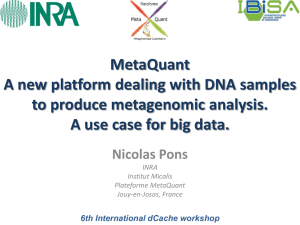



![[CLICK HERE AND TYPE TITLE]](http://s3.studylib.net/store/data/006848608_1-53ac198ad7a25d42f6bbf773b8c16286-300x300.png)


